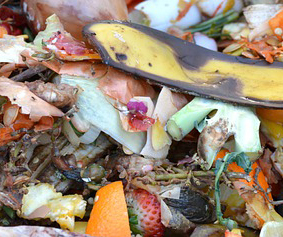Food waste is a major problem that negatively impacts the environment. While the world wastes about 1.4 billion tons of food every year, the U.S. discards more food than any other country in the world: nearly 40 million tons every year. That’s estimated to be 30% to 40% of the entire U.S. food supply. And that excess food often ends up in landfills where it contributes significantly to CO2 emissions.
A 2021 report from the EPA on the environmental impacts of food waste estimated that each year, U.S. food loss and waste embodies 170 million metric tons of carbon dioxide equivalent (million MTCO2e) GHG emissions (excluding landfill emissions)—equal to the annual CO2 emissions of 42 coal-fired power plants. EPA data also show that food waste is the single most common material landfilled and incinerated in the U.S., comprising 24% and 22% of landfilled and combusted municipal solid waste, respectively.
Subscribe to the Food Safety Tech weekly newsletter to stay up-to-date on the latest news and information on food safety.
Restaurants and food manufacturing companies all over the country are making it a priority to reduce their food waste and loss. Below, we outline the most effective strategies—as well as resources available—to help food manufacturers and restaurant staff cut food loss and waste in their facilities.
Train Cooking Staff to Make Waste Reduction Priority
Make waste reduction part of your business culture. Start with the leadership and have them employ waste reduction throughout the entire organization.
Food prep is an area that can contribute to food waste; your suppliers may be able to help. “We work with a company that includes black beans in their burritos and burrito bowls,” says Kari Hensien, president of Rizepoint. “Because the supplier was providing those beans in a size that was greater than the recipes called for restaurant employees were just dumping the whole bag in because it was ‘close enough.’”
Not only did this affect the quality of the end product, it resulted in increased costs and food loss. In similar cases, employees may throw out the excess in a can or package if it contains more than a recipe requires. “Working with your supply chain to optimize packaging to correspond with the formulation of your recipes can drive significant cost savings and reduce food waste for the business,” says Hensien. “You can also raise awareness with your staff of the importance of following that recipe and what to do with the nonstandard size materials. For example, saving it for the next batch rather than throwing it away.”
Improve Food Storage Standards and Follow Regulations
Ensure that the cooking staff and waiters know how to properly store food and use items promptly to prevent produce from spoiling. “So often food waste at retail occurs because employees are not following simple quality control techniques,” says Hensien. “Whether it’s the holding temp for food you’ve prepared or maintaining the temps for food you are storing, you want to make sure that you are reinforcing the basics of having a solid quality control HACCP program in place for doing those temp checks.”
Use Every Part of Food Products
You can use your food more efficiently and cut costs by utilizing every part of meat products, fruits, vegetables, dairy and grains. Have the cooks use every food scrap. For example, bits of tomatoes left over after making burgers can get used up in sauces or salsas.
You can use bones and vegetable leftovers to make chicken broth for a tasty noodle soup. Do you have bread that’s no longer super fresh? Then make some breadcrumbs to sprinkle on top of a fish filet or croutons for a salad.
Restaurants and food manufacturers are also finding creative ways to partner with other businesses to repurpose and make use of their leftover food products. “Are there other facilities that would take food scraps off your hands for a cost to put it into something else?” asks Hensien. “For example, a company may be willing to take your lemon peels and make them into disinfectants. Through creative collaborations you can reduce your food waste and help another company produce their product or service.”
Compost to Cut Food Waste
Composting is a great sustainability strategy for your organization. Add old bread, vegetable and fruit peels, egg shells and coffee grounds to a compost pile or work with a local composting company to take your leftovers. You can also forge partnerships with local farms and gardeners who will take you compostable materials to develop and use your nutrient-rich compost.
Legislation is making it both necessary—and easier—for food businesses to take part in composting programs. California, Connecticut, Massachusetts, New York, Rhode Island and Vermont have passed laws that restrict the amount of food waste going to landfills. Vermont’s “Universal Recycling Law,” which went into effect in July 2020, bans food scrap waste entirely.
Pending legislation in California, Colorado and Massachusetts would establish programs to fund private-sector composting and organic collection programs. In addition, several states including Tennessee and Washington, and cities like Los Angeles and Madison, Wisconsin, have created food waste task forces to reduce waste by creating composting education and infrastructure.
“You can often partner with a set of local nonprofits and/or local state agencies that will help you with a solution where they will come and get your food scraps or you can drop them off at a certain location. This does require some logistics and coordination but oftentimes we’re finding that there are simple solutions with local nonprofits available that are already in place,” says Hensien.
Inspect Your Food Deliveries and Work with Local Suppliers
You will need to check every food delivery sent to your place of business. Only accept food deliveries with fresh ingredients and nothing that looks like it’s about to spoil. Work with high-quality delivery services and certified suppliers, who follow all appropriate food safety protocols.
Also, focus on seasonal produce and ingredients from the local area, when possible. “Businesses can optimize their supply chain geographically, especially for the fresher items such as tomatoes and lettuce,” says Hensien. “The closer that supplier is to its retail destination, the lower the transportation costs and the greater the likelihood that the product will arrive in a good quality state.”
Donate Food to the Hungry
Donate excess food that is still edible to local food banks, soup kitchens and homeless shelters to feed the hungry or partner with “food rescue” initiatives that bring excess food from retailers and restaurants to people in need. Oftentimes, these organization will pick up the unused food from your business.
“A lot of those nonprofits are actively searching for partners because food insecurity in the U.S. is at an all-time high and donations to those food pantries and soup kitchens are at an all-time low,” says Hensien.
Start by connecting with your local nonprofits. You can also find U.S.-based food rescue organizations in your region here.
Use Tech Tools to Predict Ordering Quantities
A key step in reducing food loss and waste is ensuring you are ordering only the ingredients you will need and can use. “The simplest thing an organization can do to reduce loss and waste is to marry their operational data—what they are using—with their transactional data—what they are selling” says Hensien.
There are technologies and tools that will help you track historical trends and predict your sales, but tracking this data can be done manually or in spreadsheets as well.
Identify Areas of Waste or Loss
One of the best ways to reduce food waste at food manufacturing plants is to utilize a tracking system. Pay attention to the data with the help of software, such as an Enterprise Resource Planning (ERP) tool.
You will have the information you need regarding packaging, shipping and production. The data found via a tracking system can help you define areas of waste and inefficiency. You can then target those areas to decrease food waste.
There are also self-assessment tools available to help both you and your suppliers identify areas of food loss and waste. “Our industry is notorious for saying you should do an LCA assessment and then implement an FLW protocol into your auditing program, and everyone just sees: ‘Oh gosh, I’ve got to send another auditor into all these locations and do an bunch of work to get this up and going,’” says Hensien. “But you can start with simple self-assessments that you can easily assign as a task with very little overhead.”
You can download self-assessment resources through the FLW as well as the EPA, which offers a Food Assessment Guidebook and Toolkit for Reducing Wasted Food & Packaging.
By involving your entire team in the goal of reducing food waste and loss, the industry can have a significant impact in reducing food insecurity, improving profitability and protecting the environment.







